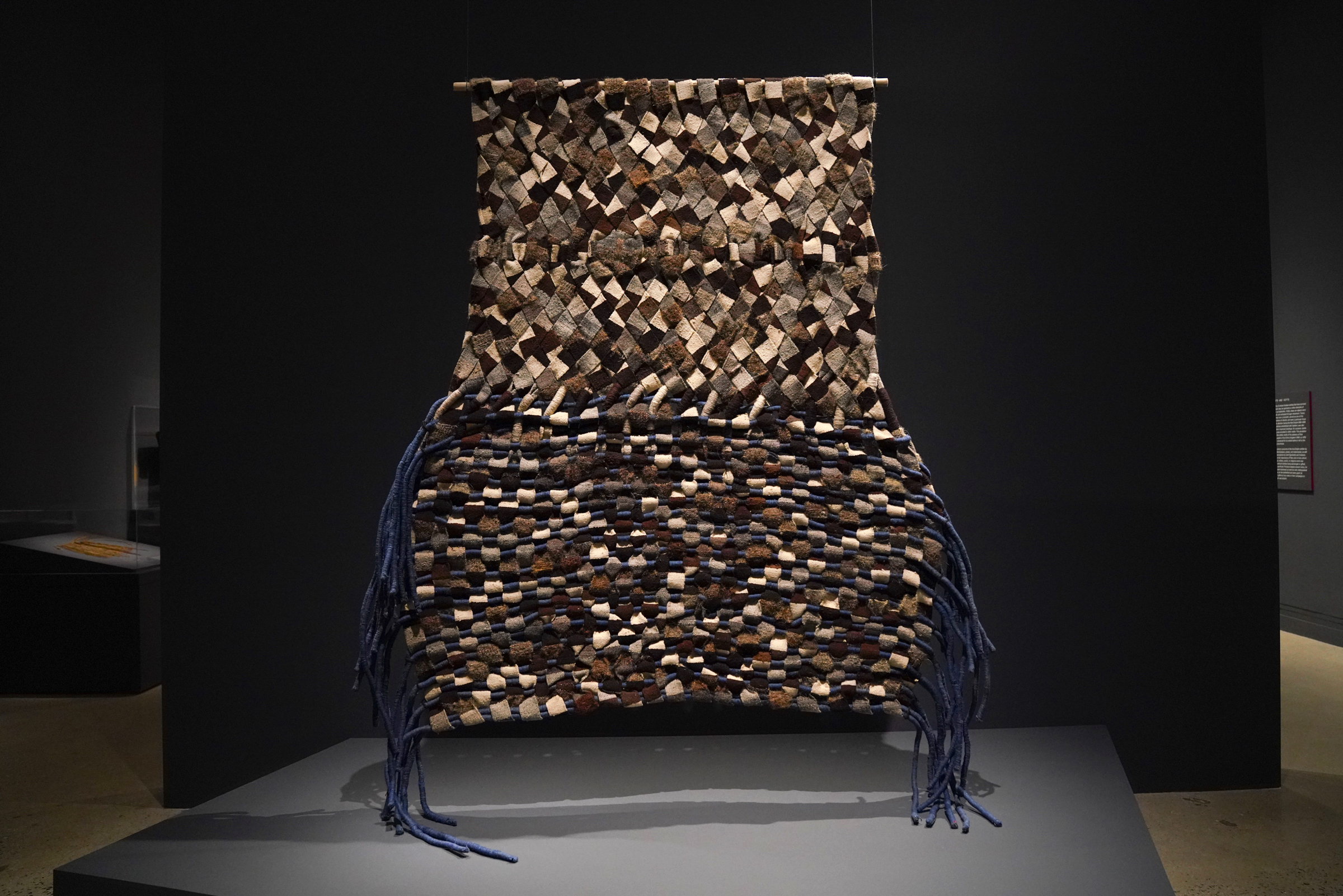A current of cross-cultural, centuries-spanning creativity powers Weaving Abstraction in Ancient and Modern Art at the Metropolitan Museum of Art. Setting out to spotlight the origins of abstract woven art, this compact exhibition brings together two bodies of textile-based artwork, about 50 pieces total. A collection of weavings made by artists from the Andean region of South America, dating approximately from the 4th century BCE through the 16th century CE are installed on one side of the gallery. On the other side hang works by four modern weavers — Olga de Amaral, Anni Albers, Lenore Tawney, and Sheila Hicks — who worked in the mid-20th century and beyond in South and North America and drew from the methods and aesthetics of pre-Columbian textiles.
Like Albers’s famed book, On Weaving, which she dedicated to her “great teachers, the weavers of ancient Peru,” the exhibition pays tribute to the designs and phenomenal technical innovations of these long-ago weavers. Set against dark gray gallery walls (with hot pink edges in spots), the show underscores the connections between the old and the new. Wall texts detail the cultural significance of the Andean objects (including garments, fringed bags for carrying coca leaves, and a khipu, an Incan knotting system for encoding messages) and highlight the textile techniques (double cloth, tubular weaving, multi-ply structures, discontinuous weaving patterns, openwork, knotted fringe, tassels) used to make them.

By placing these ancestral objects alongside 20th-century artworks that took cues from them, the exhibition aims to show how extensive archaeological excavations in the early 1900s led to the popularity of Peruvian textiles in the United States and Europe, in turn ushering in an abstract visual vocabulary for modern art. This positioning also illustrates how textile techniques seem poised to travel. Albers and Hicks, respectively, referred to the process of weaving as “the event of the thread” and “the voyage of the line.” And journeys get embedded into fabrics: Wari weavers, for example, used six to nine miles of fine thread to make a single tunic.
United by fibers and gridded structures, the show’s divide between ancient and modern textiles serves as a conceptual mirror. Colors, patterns, techniques, and materials reverberate among the works on either side of the installation. The black and white checkerboard pattern of a 16th-century Incan tunic repeats in Tawney’s seven-foot-long linen wall hanging, titled “Peruvian” (1962). With a vibrant palette (magenta, violet, brick red, peach) and graphic shapes enclosed in rectangles, de Amaral’s woolen “Geometric Play of Colors” (Juego geométrico de colores) (1962) recalls the graphic symbols in a pair of camelid-fiber Inca and Wari tunics. The meandering cream-colored threads of Hicks’s airy wall piece (“Untitled,” 1986) echo the lacy openwork of a Chancay headcloth. And the zigzag pattern of an expansive earth-toned cotton Chimú wall hanging emerges in Albers’s “Red Meander” (1954).

Seeing ancient imagery infused with cultural meaning used outside of its original context brings to mind an interview with Zapotec-American textile artist Porfirio Gutiérrez, in a chapter of Weaving at Black Mountain College that’s dedicated to contemporary artists with connections to the influential weavers who taught at the school. When asked about his relationship to Albers’s work, Gutiérrez responded, “I think [Anni’s] work has a relationship with mine,” and added that “her work is deeply inspired by my ancestors’ work and forms. Some of the designs she is known for have such deep spiritual meaning to my culture.”
But Iria Candela and Joanne Pillsbury, curators of Weaving Abstraction, state that analyzing cultural appropriation isn’t their mission with this show. “While Albers, Hicks, Tawney, and de Amaral were profoundly influenced by, and deeply invested in, studying the Andean legacy, it is not our intention to dissect how these modern artists appropriated this tradition,” they write in an essay in the 48-page publication that accompanies the exhibit. “Rather, we want to examine how artists from such distant societies mined the rich vein of textile structures to produce works of art of exceptional technical and formal refinement.”
Staring at the radiant aqua and banana-yellow color field quadrants that fill a seven-foot-wide Wari feathered panel (600 to 900 CE), time collapses and melds with awe. What initially resembled brushstrokes are actually a massive amount of macaw feathers, precisely knotted and arranged to form the velvety, geometric surface. I’m staggered by the enduring brilliance of these hues and the freshness of this design — one that’s well over a thousand years old. “It feels so contemporary,” a gallery-goer murmured to her companion behind me, as if speaking my thoughts. Standing before this work, and others in the show, I felt moved that fabrics made by the nimble hands of long-gone artists still have the power to resonate within a vastly different time and place.








Weaving Abstraction in Ancient and Modern Art continues at the Metropolitan Museum of Art (1000 Fifth Avenue, Upper East Side, Manhattan) through June 16. The exhibition was curated by Iria Candela and Joanne Pillsbury.










